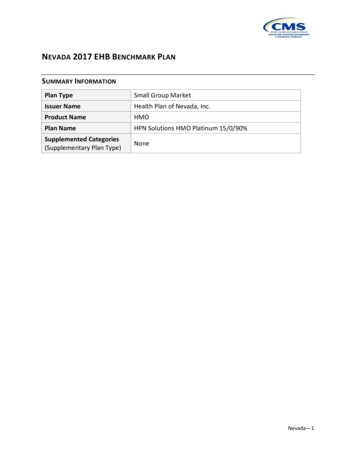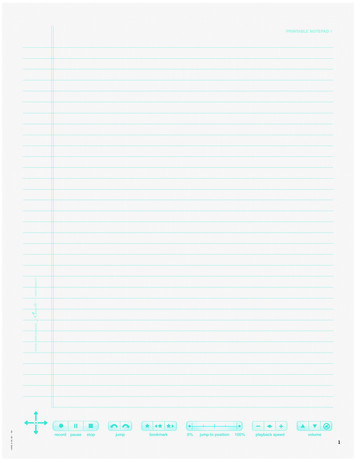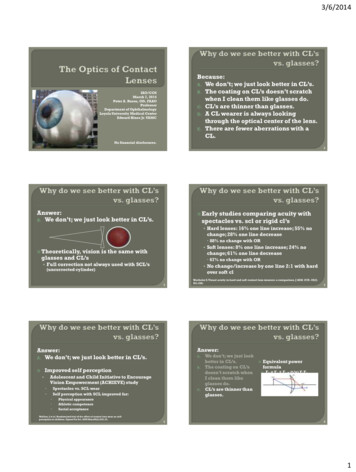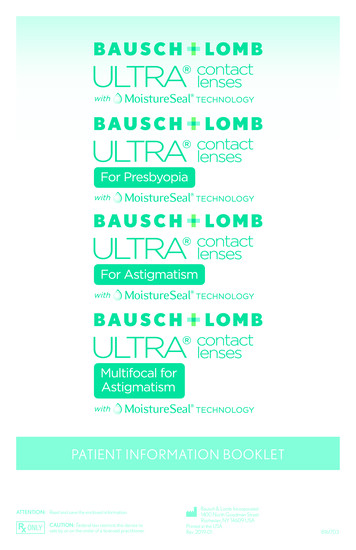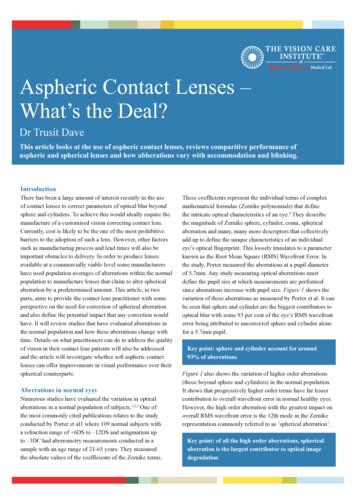
Transcription
Contact Lenses for the Correction of AstigmatismClick Here for Important informationOn How to Get the Most out of this CourseAstigmatism: A Brief ReviewAstigmatism is a common refractive error which is correctable through the use of eyeglasses, contact lenses orsurgery.If we think of the normal cornea as being essentially spherical in shape, when light enters the eye, it is refracted or“bent” evenly in all directions, resulting in a sharp point of focus on the retina. However, if astigmatism is presentthe cornea is shaped more like a football or the back of a spoon. So when light enters the eye it is refracted more inone direction than the other, resulting in blurred vision in at least one of the two principal meridians.Astigmatism can be hereditary and is often present at birth. It can also result from pressure from the eyelids on thecornea, incorrect posture or an increased use of the eyes for close work. Untreated it can cause headaches,fatigue, eyestrain and blurred vision at all distances. Astigmatism can almost always be corrected with properlyprescribed eyeglasses or contact lenses. In cases with only a small amount of astigmatism, corrective lenses maynot be needed at all, as long as other conditions such as myopia or hyperopia are not present. If the astigmatism ismoderate to high, however, corrective lenses are probably needed.Correcting AstigmatismCorrective spectacle or contact lenses containing cylinder are used for the correction of astigmatism. These lenseshave greater refractive power in one direction than the other. Another method for correcting astigmatism is bychanging the shape of the cornea through refractive or laser eye surgery. While there is more than one type ofrefractive surgery, specific treatments are recommended on an individual basis. Refractive surgeries requirehealthy eyes that are free from retinal problems, corneal scars and any eye disease.Regular and Irregular AstigmatismAstigmatism may be divided into two broad categories: regular and irregular. Irregular astigmatism is caused by adiseased or damaged cornea resulting in light scattering in the crystalline lens. Irregular astigmatism cannot becorrected by standard spectacle lenses.However rigid gas permeable (RGP) contact lenses can help treat regular astigmatism due to the tear lens whichfills in the irregularities and re-creates a smooth optical surface. There will be more on the tear lens later in thiscourse.Regular astigmatism, which can be caused by either the cornea or crystalline lens, can be corrected by a toric(cylindrical) lens. A toric surface resembles the surface of a football where there are two curves, one steeper thanthe other. This optical shape results in regular astigmatism.With-the-rule and against-the-rule astigmatismIn with-the-rule corneal astigmatism, the cornea is steeper in the vertical meridian and flatter in the horizontal.Imagine holding a football with the tips of the ball held horizontally. The flatter curve is in the horizontal and thesteeper curve in the vertical. That would represent with the rule astigmatism. If the football were held vertically, withthe steeper curve in the horizontal and the flatter curve in the vertical that would represent against the ruleastigmatism.Copyright 2013 Optical Training Institute – Irvine, California1
Astigmatism with-the-ruleAstigmatism against-the-ruleIn with-the-rule astigmatism, the eye sees vertical lines sharper than horizontal lines. Against-the-rule astigmatismthe horizontal meridians are sharper. Axis is always recorded as an angle in degrees between 0 and 180 degreesin a counter-clockwise direction. 0 and 180 lie on a horizontal line at the level of the centre of the pupil, and as seenby an observer 0 lies on the right of both eyes.Copyright 2013 Optical Training Institute – Irvine, California2
Types of AstigmatismToric Contact LensesSoft toric contact lenses for the correction of astigmatismToric soft lenses have different curves in different meridians to correct astigmatism. Special weighting and/or thinzones in toric lenses keeps the proper lens meridian in front of the corresponding meridian of the eye and preventsthe lens from rotating during wear.Because they have a more sophisticated design, toric soft lenses are more expensive to manufacture and costmore than regular soft lenses.Spherical soft contact lenses have the same curve in all meridians and cannot correct astigmatism.Copyright 2013 Optical Training Institute – Irvine, California3
Rigid gas permeable (RGP) contact LensesAs their name implies, rigid gas permeable (RGP) lenses are hard lenses. They maintain their shape on the eyeand don’t conform to the unequal contours of an astigmatic eye like soft lenses do.When an RGP contact lens is worn on an eye that has mild to moderate astigmatism, the space between the(spherical) back surface of the contact lens and the (astigmatic) front surface of the cornea is filled with tears. Thislayer of tears is shaped in such a way that it becomes, in effect, a lens that fully corrects the astigmatism of the eye.This “tear lens” behind the RGP contact lens is unaffected by lens rotation. Therefore the only lens power requiredin the contact lens is the power needed to correct any myopia or hyperopia that exists along with the astigmatism.In cases of moderate to severe astigmatism, a standard rigid gas permeable contact lens may be uncomfortable orunstable on the eye because the shape of the cornea is so irregular that the contact lens doesn’t center properly onthe eye and moves (or “rocks”) too much during blinks. In these cases, a toric RGP contact lens may be used.A toric RGP lens has a spoon-shaped back surface that more closely matches the front surface of an astigmaticeye for a more stable and comfortable fit. This closer fitting relationship also keeps the lens from rotating on theeye, allowing different powers (curves) to be ground on different meridians of a toric RGP lens. The variable powerson the lens surface correct the astigmatism without having to rely solely on the power of the “tear lens” between thecornea and the back surface of the lens. The front surface of a toric RGP lens may be spherical or toric, dependingon the required prescription. (If both the front and back surfaces are toric, the lens is called a bitoric lens.)Because toric rigid gas permeable lenses have a more sophisticated design, they are more expensive tomanufacture and therefore cost more than regular RGP contact lenses.When Toric Contact Lenses are indicatedToric contact lenses may be indicated when residual astigmatism results in vision which is compromised. Residualastigmatism may result from a toric posterior corneal surface, a toric crystalline lens, or a partially dislocatedcrystalline lens.Toric lenses may also be required when moderate to high corneal astigmatism results in either mechanical irritationor centration problems with spherical hard lenses.Astigmatic contact lenses may be classified into the following categories and these are applicable to both hard andsoft lenses.A) Anterior toric, with spherical back surfaceB) Posterior toric base curves1. Posterior toric only2. BitoricAnterior toric with spherical back surfaces: These are available in both hard and soft lenses. They are typically fitwhen there is a significant amount, generally more than 0.75 D, of uncorrected residual astigmatism. The correctingcylinder is put on the front surface of the lens while the diameter and posterior curves remain the same.Posterior base curve toric lens: These are available in both hard and soft lens materials, although they are usedpredominately with hard lenses. They are indicated when a spherical lens does not provide a stable fit and whenthere is at least 1.50 diopters of corneal astigmatism. They can also be indicated when irritation is experienced dueto inadequate clearance of a spherical lens on a corneal cylinder.A bitoric lens design is needed when the back toric surface results in enough residual astigmatism so that a frontsurface correcting cylinder is needed. At least 1.50 diopters of corneal astigmatism should be present.Stabilization Techniques for Toric Contact LensesMany of the techniques used for stabilizing toric contact lenses are also used for the stabilization of segment stylemultifocal lenses. In either case, for obvious reasons, lens rotation on the eye needs to be minimized.Copyright 2013 Optical Training Institute – Irvine, California4
Prism Ballast:This is one of the most common stabilizing techniques. A prism of between 1.00 to 1.50 D isground base down into the lens.However, greater amounts of prism may be needed for patients with particularly tight lids, flatcorneas, or oblique axis astigmatism. The lens will tend to rotate so that the base of the prismis oriented inferiorly. The added thickness of the lens along the prism base can reduce oxygenpermeability through that portion of the lens resulting in possible hypoxic disturbances in theinferior zone of the cornea.Truncation:Prism BallastWhen a lens is truncated, a portion of it is sectioned off. It is usually 0.50 to 1.5 mm on thelower edgeof the lens. The amount sectioned off will depend on the size of the lens; larger lensesrequire greater amounts than smaller lenses. Occasionally the upper edge is sectioned offas well resulting in a double truncated lens.The truncation will serve to stabilize a lens when the lower flat edge comes to lie adjacentto the lower eyelid margin. Truncation is often combined with prism ballast.When a lens is truncated its diameter is effectively reduced which results in a looser fit. Tocompensate for this the base curves of truncated lenses are generally made somewhat steeper.TruncatedDouble Slab-off lenses:This technique creates a lens which is thicker along its central body which lies along thepalpebral fissure and thinner along the inferior and superior edges which come to lie underthe upper and lower lids. This technique is comfortable since there is no lid impact alongthe inferior surface. However it does not offer as much lens stability as the truncated orposterior toric techniques. Double slab-off lenses are often combined with a prism ballast tohelp prevent rotation.Posterior Toric Lenses:Double Slab OffA back toric surface can be used as a lens stabilizing technique. When the shape of theposterior contact lens surface closely parallels that of the cornea lens rotation can be minimized.Aspheric Lens Surface:An aspheric surface can aid in lens-axis stabilization by adding drag to the motion of the lens. It is generally used incombination with truncation or prism ballast since it is only minimally effective by itself.Toric Reference MarkingsBecause it is necessary to inhibit lens rotation, toric lenses will typically come with reference markings so the fittercan determine how the lens is oriented on the cornea. If one were to superimpose the face of a clock over thecornea, these markings, which may be circles or lines, are located at the six-o-clock or three and nine-o-clockmeridians. Each hour on the clock represents 30º. So if a lens becomes oriented at five-o-clock that means it hasrotated 30º to the right, while seven-o-clock is 30º to the left.The expression LARS stands for left add, right subtract. If the lens is rotated to the fitter’s left, the appropriatenumber of degrees is added to the prescribed axis. If it is rotated to the right the appropriate number of degrees issubtracted.Copyright 2013 Optical Training Institute – Irvine, California5
Lens rotation can be measured using a slit lamp equipped with a protractor.The use of trial lenses is especially important when fitting toric contact lenses.How the tear lens can correct for significant amounts of corneal astigmatismLet’s first consider a spherical lens on a spherical cornea.A: Figure A below illustrates rigid contact lens fit “on K” where the base curve of the lens parallels the curvature ofthe cornea. In this case the power of the tear lens is plano. When there is corneal astigmatism, a lens fit “on K”parallels the flatter of the two corneal meridians.Copyright 2013 Optical Training Institute – Irvine, California6
B: Figure B shows a rigid contact lens which is fit steeper than K. Note that the shape of the resultant tear lens isthicker in the center and thinner on the edges which produces a lacrimal lens with plus power. The power of thelacrimal or liquid lens must be considered when determining the correct power the contact lens.C: In figure C the rigid contact lens is fit flatter than K resulting in a tear lens which is thinner in the center andthicker on the edges. The lacrimal lens in this case will contain minus power.How the tear lens can correct for significant amounts of corneal astigmatismExample 1:Spectacle Rx: -3.25K: 43.50 Vertex distance 12 mmUsing the data above, what would be the power of a rigid the contact lens which is fit on K?When a lens is fit “on K” it indicates that its base curve is designed to parallel the flattest corneal meridian. In thiscase we are presented with a “spherical” cornea. Therefore a lens fit on K would contain a base curve of 43.50which is equal to the curvature of the flattest (in this case only) corneal meridian. As indicated in figure A on theprevious page when the back curve of the contact lens parallels the front curve of the cornea the power of the tearlens produced is plano or zero.The Rx in this example tells us that a spectacle lens with a power of -3.25 D is needed to correct this person’smyopia. Since the power at the spectacle plane is less than -4.00, it is not necessary to compensate for vertexdistance. The total power of the contact lens plus the power of the tear lens needs to equal -3.25. Since the tearlens is plano, the power of the contact lens would be -3.25.Using the data above, what is the power of a rigid contact lens fit 0.50 D steeper than K?In this example a lens fit 0.50 D steeper than K would contain a base curve of 44.00 diopters. Since it is steeperthan K the shape of the tear lens would resemble the one in figure B on the opposite page, thicker in the center andthinner on the edges thereby creating a liquid lens of plus power. How much plus power? If it is 0.50 D steeper thanK the power of the tear lens is approximately equal to 0.50 D. As previously stated, the total power needed at thecorneal plane is -3.25 D which will be the combined power of the contact lens plus the tear lens. If the tear lenscontains a power of 0.50, therefore, the contact lens must contain a power of -3.75. So, -3.75 (contact lens power)plus 0.50 (tear lens power) results is the desired -3.25 diopters of power at the corneal plane.Using the data in example one above what is the power of a rigid contact lens which is fit 0.25 D flatter than K?Copyright 2013 Optical Training Institute – Irvine, California7
When the lens is fit flatter than K the shape of the tear lens will resemble figure C on page 6, thinner in the centerand thicker on the edges thus creating a liquid lens containing minus power. How much minus power? When thecontact lens is fit 0.25 diopter flatter than K the power of the tear lens is equal to approximately -0.25 diopter. Sincethe combined power of both the contact lens and tear lens needs to be -3.25 D, the contact lens would require apower of -3.00. So -3.00 (contact lens power) plus -0.25 (tear lens power) results in the needed -3.25 diopters atthe corneal plane.How the tear lens can correct for significant amounts of corneal astigmatismExample 2:Spectacle Rx: -6.75 - 1.00 x 180K readings: 44.50\45.50Vertex Distance: 12 mmWhen presented with a spectacle prescription containing cylinder for the correction of astigmatism, it must first bedetermined how much of that astigmatism is the result of a toricity in the front surface of the cornea, cornealastigmatism, and how much of it may be residual astigmatism. Residual astigmatism may be caused by a toricity inthe crystalline lens, a toricity in the posterior surface of the cornea, or by some other reason. For now we’ll observethe toricity of the cornea as indicated by the K readings and compare it to the amount of cylinder included in therefraction. In example 2 above it can be observed that one diopter of cylinder is included in the spectacleprescription. By analyzing the K readings we can also see that there is one diopter of toricity in the front surface ofthe cornea. Therefore, all the astigmatism is found in the cornea and no residual astigmatism is present. When thissituation occurs it is often possible to completely correct the corneal astigmatism using a spherical rigid contactlens.To achieve this, it is first necessary to transpose the prescription to minus cylinder form and then drop the cylinderand axis. It is then possible to fit the lens as if it were a spherical prescription following the guidelines discussed.Looking at example 2 on the previous page we can observe that there is one diopter of cylinder in the spectacleprescription and one diopter of toricity on the front surface of the cornea. Therefore all the astigmatism is corneal.The Rx is already in minus cylinder form so by dropping the cylinder and axis we are left with -6.75 at the spectacleplane. Since this power is greater than 4.00 diopters it is necessary to compensate for vertex distance. A -6.75diopter spectacle lens at 12 mm, would need to be compensated to -6.24 at the corneal plane. Rounding off to thenearest quarter diopter gives us -6.25. What this means is that the total power of the contact lens plus the tear lensat the corneal plane needs to equal -6.25 dioptors.We can now proceed as in example 1. If the lens is fit on K the tear lens is plano thus requiring a -6.25 dioptercontact lens. If fit steeper than K the tear lens contains plus power which would then require more minus power inthe contact lens. If the lens is fit flatter than K the tear lens would then contain minus power thereby requiring lessminus (or more plus power) in the contact lens.So if the lens in example 2 were fit on a 44.75 diopter base curve, what contact lens power would be required?Since 44.75 is 0.25 D steeper than K the tear lens contains a plus power of 0.25 diopter. Therefore the contactlens power must be -6.50 which, when combined with the tear lens power of 0.25 diopter, yields the desired -6.25dioptors.Copyright 2013 Optical Training Institute – Irvine, California8
How a spherical rigid contact lens can correct for corneal astigmatismThe illustration above demonstrates how a spherical rigid contact lens can correct for corneal astigmatism. Byanalyzing this prescription utilizing an optical cross we can see that the power of the lens along the 180 meridian is-3.00 D and the power in the 90 meridian is -3.50 D. If a -3.00 D rigid contact lens is fit on K, the power of theresultant tear lens along the 180 meridian is plano, so the power of the contact lens in that meridian needs to be 3.00 dioptors. Since the corneal curvature is steeper along the 90 meridian, the tear layer forms a minus lens witha power of approximately -0.50 diopter. When combined with the -3.00 D contact lens, the total power of the twolenses in this meridian equals -3.50. Thus the combined power of the tear lens plus the contact lens in eachprincipal meridian contains the power called for by the prescription—and this has been achieved through the use ofa spherical rigid contact lens.ConclusionAchieving success in fitting toric contact lenses for the correction of astigmatism requires the expertise of amotivated fitter as well as a motivated patient. New toric soft lens products are continually reaching the market andpromise more successful fits for the astigmatic patient who wishes to wear contact lenses.Copyright 2013 Optical Training Institute – Irvine, California9
Toric lenses may also be required when moderate to high corneal astigmatism results in either mechanical irritation or centration problems with spherical hard lenses. Astigmatic contact lenses may be classified into the following categories and these are applicable to both hard and soft lenses. A) Anterior toric, with spherical back surface B .
